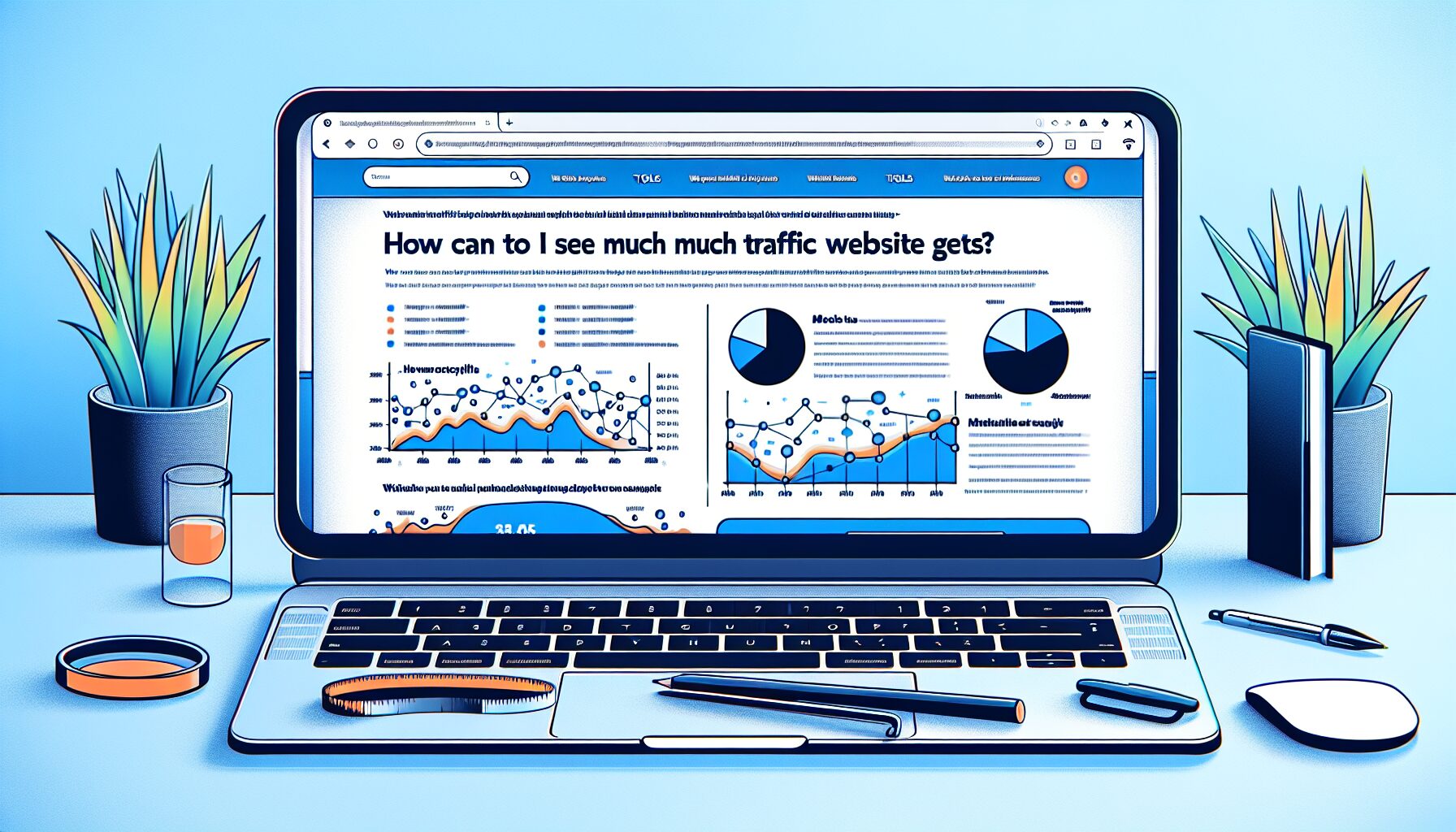Have you ever wondered how popular a website is or how much traffic it receives? If so, you’re not alone. In this article, we will explore various methods and tools that will help you find out exactly how much traffic a website gets. Whether you’re a business owner looking to spy on your competition or simply curious about the popularity of your favorite website, we’ve got you covered. So sit back, relax, and get ready to uncover the secrets behind website traffic!

Using Website Analytics Tools
Google Analytics
Google Analytics is a powerful tool that allows you to track and analyze various aspects of your website’s performance. It provides valuable insights into your website’s traffic, including the number of visitors, pageviews, bounce rate, and much more. With Google Analytics, you can track the effectiveness of your marketing campaigns, identify areas for improvement, and make data-driven decisions to optimize your website.
SimilarWeb
SimilarWeb is another popular website analytics tool that provides a comprehensive overview of a website’s traffic and audience. It offers detailed information on the total visits, traffic sources, referring sites, user engagement, and audience demographics. SimilarWeb also allows you to compare your website’s performance with competitors, helping you gain insights into their strategies and identify potential opportunities for growth.
Alexa
Alexa is a well-known website analytics tool that offers a range of features to help you understand and improve your website’s performance. One of its key metrics is the Alexa Rank, which provides an estimate of a website’s popularity based on its traffic data. Additionally, Alexa offers insights into audience overlap, search traffic, and competitor analysis, enabling you to benchmark your website against others in your industry and make informed decisions.
SEMrush
SEMrush is a comprehensive digital marketing platform that offers a suite of tools for SEO, advertising, content marketing, and more. Within SEMrush, you can access valuable website traffic data, including organic and paid traffic, keyword rankings, backlink analysis, and competitor monitoring. This data allows you to understand how your website is performing in search engine results and identify opportunities to improve your online visibility.
Quantcast
Quantcast provides website analytics tools that focus on audience measurement and demographic insights. With Quantcast, you can understand the characteristics of your website’s visitors, including their age, gender, interests, and online behavior. This information helps you tailor your content and marketing efforts to better reach and engage your target audience, ultimately driving more traffic to your website.
SpyFu
SpyFu specializes in competitive analysis and allows you to gain valuable insights into your competitors’ online strategies. With SpyFu, you can uncover your competitors’ most profitable keywords, ad campaigns, and backlinks, allowing you to capitalize on their successes and outperform them in search engine rankings. By analyzing your competitors’ tactics, you can make informed decisions to drive more targeted traffic to your website.
Checking Public and Third-Party Data
Alexa Rank
The Alexa Rank is a widely used metric to assess a website’s popularity and reach. It provides a numerical ranking based on a website’s estimated traffic compared to other websites. The lower the Alexa Rank, the higher the website’s traffic and popularity. While the Alexa Rank should be taken with a grain of salt and not used as the sole measure of a website’s success, it can be a useful benchmarking tool to compare your website’s performance to others in your industry.
Competitor Analysis Tools
When it comes to measuring website traffic, it’s important to consider your competitors’ performance as well. Competitor analysis tools, such as SimilarWeb and SEMrush, allow you to gain insights into your competitors’ website traffic, traffic sources, keywords, and more. By understanding what is driving traffic to their websites, you can identify opportunities to improve your own website and attract more visitors.
Domain Authority
Domain Authority is a metric developed by Moz that predicts how likely a website is to rank high in search engine results. It takes into account various factors, including the number and quality of backlinks, website age, and other SEO indicators. While Domain Authority is not a direct measure of website traffic, it is often correlated with higher traffic levels. Increasing your website’s Domain Authority can help improve your organic search rankings and drive more traffic to your site.
Backlink Checking Tools
Backlinks play a crucial role in determining a website’s authority and visibility in search engine results. Backlink checking tools, such as Ahrefs and Moz’s Link Explorer, allow you to analyze the backlinks pointing to your website and monitor your competitors’ backlink profiles. By evaluating the quality, quantity, and relevance of backlinks, you can identify opportunities to build and improve your website’s backlink profile, ultimately driving more traffic to your site.
Social Media Metrics
Social media platforms provide their own analytics tools that allow you to track and analyze the performance of your social media presence. Facebook Insights, Twitter Analytics, Instagram Insights, LinkedIn Analytics, Pinterest Analytics, and YouTube Analytics provide valuable data on engagement, reach, impressions, and more. By understanding the performance of your social media content, you can optimize your strategies to drive more traffic to your website.
Website Review Platforms
Website review platforms, such as Yelp and Trustpilot, offer insights into customer feedback and ratings. Monitoring these platforms allows you to understand how your website is perceived by users and identify areas for improvement. Additionally, aggregating reviews from various platforms can provide a comprehensive overview of your website’s reputation and help build trust with potential visitors, ultimately driving more traffic to your site.
Examining Search Engine Results
SERP Rankings
Search engine rankings play a crucial role in determining the visibility and traffic of your website. Higher rankings for relevant keywords can result in more organic traffic, as users are more likely to click on higher-ranked search results. Monitoring your website’s search engine rankings allows you to identify opportunities to improve your SEO and increase the visibility of your website in search results.
Keyword Research Tools
Keyword research tools, such as Google Keyword Planner, SEMrush, and Ahrefs, help you identify the most relevant and valuable keywords for your website. These tools provide data on search volume, competition, and related keywords, allowing you to optimize your website’s content and meta tags to target high-traffic keywords. By incorporating these keywords into your website, you can increase your chances of ranking higher in search engine results and driving more organic traffic.
SEM and SEO Software
SEM (Search Engine Marketing) and SEO (Search Engine Optimization) software, such as Google Ads, SEMrush, and Moz, provide valuable insights and tools to optimize your website’s search engine visibility. These tools allow you to track the performance of your paid search campaigns, optimize your website’s on-page and off-page SEO, monitor your backlink profile, and much more. By utilizing SEM and SEO software, you can improve your website’s search engine rankings and drive more targeted traffic to your site.
Analyzing Website Traffic Data
Website Traffic Analysis
Analyzing website traffic data is essential to understanding how your website is performing and identifying areas for improvement. Website analytics tools, such as Google Analytics, provide valuable data on the number of visitors, pageviews, session duration, and other metrics. By regularly monitoring and analyzing this data, you can identify trends, measure the impact of marketing campaigns, and make data-driven decisions to optimize your website and drive more traffic.
Unique Visitors
The number of unique visitors refers to the total number of distinct individuals who have visited your website within a specific time frame, regardless of the number of times they visited. Tracking unique visitors allows you to understand the size of your website’s audience and gauge the effectiveness of your marketing efforts in attracting new visitors. Increasing the number of unique visitors can result in more potential customers and opportunities for engagement.
Pageviews
Pageviews represent the total number of times a specific page on your website has been viewed within a given time period. This metric helps you understand which pages on your website are the most popular and engaging for your audience. By analyzing pageviews, you can identify content that resonates with your visitors and optimize underperforming pages to drive more traffic and improve user engagement.
Bounce Rate
The bounce rate measures the percentage of visitors who land on a page of your website and then leave without interacting with any other pages. A high bounce rate may indicate that visitors are not finding what they are looking for or that your website’s content or user experience needs improvement. By analyzing the bounce rate, you can identify problematic pages and take steps to optimize them, reducing bounce rates and keeping visitors engaged on your website.
Referral Traffic
Referral traffic refers to visitors who land on your website from external sources, such as other websites, social media platforms, or online directories. Analyzing referral traffic allows you to understand which sources are driving visitors to your website and evaluate the effectiveness of your referral marketing efforts. By identifying top referring sites, you can optimize your strategies to increase referral traffic and attract more visitors.
Organic Traffic
Organic traffic represents visitors who arrive on your website through search engine results, rather than through paid advertisements or other sources. Increasing organic traffic is often a goal of search engine optimization efforts, as it indicates that your website is appearing in relevant search results and attracting potential customers. Analyzing organic traffic allows you to assess the impact of your SEO strategies and identify opportunities for improvement.
Paid Traffic
Paid traffic refers to visitors who land on your website through paid advertisements, such as Google Ads or social media advertising. By analyzing paid traffic, you can measure the effectiveness of your paid advertising campaigns and determine the return on investment. Understanding the impact of paid traffic on your website can help you optimize your advertising strategies and allocate your marketing budget more effectively.
Mobile Traffic
Analyzing mobile traffic is crucial in today’s mobile-first world. Mobile traffic refers to visitors who access your website using mobile devices, such as smartphones or tablets. With the increasing prevalence of mobile browsing, it’s important to optimize your website for mobile devices and ensure a seamless user experience. By tracking mobile traffic, you can identify any issues or opportunities for improvement and enhance the mobile browsing experience for your visitors.
Location of Visitors
Understanding the geographic location of your website’s visitors provides valuable insights into your target audience and allows you to tailor your content and marketing strategies accordingly. Website analytics tools often provide data on the countries, regions, and cities where your visitors are located. By analyzing this data, you can identify geographic trends, localize your content, and target specific regions or markets to drive more relevant traffic to your website.
Demographics
Analyzing the demographics of your website’s visitors allows you to understand their age, gender, interests, and other characteristics. This information can help you personalize your content, tailor your marketing efforts, and create targeted campaigns to attract and engage your ideal audience. By catering to the preferences and needs of your target demographic, you can increase the likelihood of converting visitors into customers and drive more relevant traffic to your site.
User Engagement Metrics
User engagement metrics, such as time spent on page, pages per session, and click-through rate, provide insights into how visitors interact with your website. By analyzing these metrics, you can assess the effectiveness of your website’s design, content, and user experience. Improving user engagement metrics can lead to increased visitor satisfaction, longer browsing sessions, and higher conversion rates, ultimately driving more traffic and revenue for your website.

Utilizing Webmaster Tools
Google Search Console
Google Search Console is a free tool provided by Google that allows website owners to monitor and optimize their website’s presence in Google search results. With Google Search Console, you can track your website’s performance in search, submit XML sitemaps, monitor crawl errors, identify indexing issues, and optimize your website for mobile devices. By utilizing this tool, you can ensure that your website is effectively indexed by Google and improve its visibility in search results.
Bing Webmaster Tools
Bing Webmaster Tools is a free service provided by Bing, Microsoft’s search engine, that allows website owners to monitor and optimize their website’s presence in Bing search results. Similar to Google Search Console, Bing Webmaster Tools provides insights into your website’s performance in Bing search, crawl errors, indexing issues, and more. By using Bing Webmaster Tools, you can maximize your website’s visibility in Bing search results and attract additional traffic from Bing users.
Yandex.Webmaster
Yandex.Webmaster is a free tool provided by Yandex, the leading search engine in Russia and other Russian-speaking countries. It allows website owners to monitor and optimize their website’s presence in Yandex search results. Yandex.Webmaster provides insights into your website’s indexing status, search queries, and performance on Yandex search. By utilizing this tool, you can ensure that your website is effectively indexed by Yandex and improve its visibility in Russian search results.
Using SimilarWeb
Discover Total Visits
SimilarWeb provides valuable data on the total number of visits a website receives. This metric gives you an estimate of the overall traffic of a website and allows you to compare it with competitors in your industry. By understanding the total visits of a website, you can assess its popularity and reach, identify potential partnership opportunities, and gain insights into its success.
Analyze Traffic Sources
SimilarWeb also offers insights into the various sources of traffic that a website receives. Whether it’s organic search, direct traffic, referrals from other websites, or social media, analyzing traffic sources allows you to understand how a website attracts visitors and the effectiveness of its marketing efforts. By analyzing traffic sources, you can identify opportunities to improve your own website’s traffic acquisition strategies and drive more targeted visitors.
Identify Top Referring Sites
Knowing which websites are the top referring sources for a particular website can provide valuable insights into potential partnership opportunities. SimilarWeb allows you to identify the websites that are sending the most traffic to a given website. By engaging with these top referring sites, you can establish partnerships, collaborations, or guest posting opportunities to increase your own website’s visibility and attract more visitors.
Explore User Engagement
User engagement is a crucial factor in determining the success of a website. SimilarWeb provides various metrics, such as average visit duration, pages per visit, and bounce rate, that allow you to assess a website’s user engagement. By understanding how users interact with a website and how engaging its content is, you can gain insights into best practices and optimize your own website to improve user engagement and encourage visitors to stay longer.
Observe Audience Demographics
SimilarWeb provides demographic data that allows you to understand the characteristics of a website’s audience. This includes age, gender, interests, and other demographic information. By analyzing audience demographics, you can better understand your target audience, tailor your content and marketing strategies accordingly, and attract more relevant traffic to your own website.
Analyze Competitors
One of the key advantages of SimilarWeb is the ability to analyze your competitors’ websites. By comparing your website’s performance with that of your competitors, you can gain valuable insights into their strategies and identify potential opportunities for growth. SimilarWeb allows you to analyze competitors’ traffic sources, referring sites, audience demographics, and engagement metrics, helping you benchmark your website’s performance and make data-informed decisions to improve your own traffic.

Examining Alexa Rank
Understanding Alexa Traffic Rank
Alexa Traffic Rank is a metric developed by Alexa that provides an estimate of a website’s popularity and reach based on its traffic data. The Alexa Rank assigns a numerical value to a website, with lower numbers indicating higher traffic and popularity. It’s important to note that the Alexa Rank is based on a sample of users who have installed the Alexa Toolbar or used Alexa browser extensions, so it may not be fully representative of a website’s actual traffic.
Usage of Alexa Rank
While the Alexa Rank should not be the sole measure of a website’s success, it can be a useful tool for benchmarking and comparing your website’s performance to others in your industry. By monitoring your website’s Alexa Rank over time, you can assess the impact of your marketing efforts, track your progress, and identify trends. Additionally, the Alexa Rank can provide insights into potential partnerships, advertising opportunities, and monetization strategies.
Determining Top Traffic Countries
Alexa provides data on the top traffic countries for a particular website. This information allows you to identify where a website’s audience is primarily located and tailor your marketing strategies accordingly. By focusing on regions or countries that drive the most traffic for a specific website, you can optimize your content, advertising campaigns, and customer support to better serve those audiences and attract more visitors.
Analyzing Audience Overlap
Alexa allows you to analyze the audience overlap between your website and others in your industry. This data provides insights into the shared audience between websites and allows you to identify potential partnership opportunities or collaborations. By understanding the overlap in audience between your website and competitors, you can identify ways to differentiate yourself, capture a larger share of the market, and attract more visitors.
Checking Search Traffic
Alexa provides valuable data on the search traffic of a website, including the percentage of traffic that comes from search engine results. This information helps you understand the reach and visibility of a website in search engine rankings. By analyzing the search traffic of your own website and competitors, you can identify opportunities to improve your SEO strategies, increase organic traffic, and drive more targeted visitors to your site.
Comparing with Competitors
One of the key features of Alexa is the ability to compare your website’s performance with that of your competitors. By analyzing competitors’ Alexa Ranks, traffic sources, audience demographics, and engagement metrics, you can gain valuable insights into their strategies and identify potential areas for improvement. Alexa’s competitor analysis features allow you to benchmark your website’s performance, track your progress, and make data-driven decisions to stay ahead of the competition.
Analyzing Backlink Profile
Backlinks Importance
Backlinks are crucial for a website’s search engine rankings and visibility. A backlink is a link from another website to your website, and search engines view backlinks as a vote of confidence and authority. The more high-quality and relevant backlinks a website has, the higher its chances of ranking well in search engine results. Analyzing a website’s backlink profile allows you to measure its authority, identify opportunities to build new backlinks, and improve its overall search engine visibility.
Backlink Analysis Tools
There are several backlink analysis tools available that allow you to analyze a website’s backlink profile. Tools like Ahrefs, Moz’s Link Explorer, and SEMrush provide valuable insights into a website’s backlinks, including the number of backlinks, their quality, anchor texts, and referring domains. By utilizing these tools, you can evaluate your own website’s backlink profile, monitor your competitors’ backlinks, and identify opportunities to improve your website’s authority and visibility.
Crawling Backlinks
Crawling backlinks involves using tools like Ahrefs, Moz’s Link Explorer, or SEMrush to scan the internet and gather information about the backlinks pointing to a specific website. These tools analyze the link structure of the internet and provide valuable data on backlinks, including their quality, quantity, and relevance. By crawling backlinks, you can gain insights into your own website’s backlink profile, monitor the backlinks of your competitors, and identify opportunities to build new high-quality backlinks.
Checking Referring Domains
Referring domains represent the websites that link to your website. Analyzing referring domains allows you to assess the diversity and quality of the websites that are linking to your site. Ideally, you want to have a diverse range of referring domains, as this indicates that your website is trusted and has authority in its niche. By checking referring domains, you can identify the websites that are linking to your competitors, evaluate the relevance and quality of your own backlinks, and develop a strategy to attract new high-quality referring domains.
Analyzing Anchor Texts
Anchor text is the clickable text in a hyperlink. Analyzing anchor texts allows you to understand how other websites are linking to your website and the keywords they are using. It’s important to have a variety of anchor texts that are relevant to your website’s content, as this helps search engines understand the context of your website and improve its search engine rankings. By analyzing anchor texts, you can ensure that your backlinks are optimized for relevant keywords and develop a strategy to improve the diversity and quality of anchor texts pointing to your site.
Evaluating Follow vs. Nofollow
Follow and nofollow are link attributes that indicate to search engines whether a particular backlink should be considered in their ranking algorithms. Follow links pass authority and influence search engine rankings, while nofollow links do not. Evaluating the ratio of follow and nofollow links in your website’s backlink profile helps you understand the distribution of link types and optimize your backlink acquisition strategies. While nofollow links may not directly impact search engine rankings, they can still drive valuable referral traffic and improve the overall visibility and authority of your website.
Identifying Low-Quality and Toxic Backlinks
Not all backlinks are created equal, and low-quality or toxic backlinks can have a negative impact on your website’s search engine rankings. Analyzing your backlink profile allows you to identify low-quality or toxic backlinks and take appropriate action to disavow or remove them. Low-quality or toxic backlinks can come from irrelevant or spammy websites and can harm your website’s online reputation. By regularly monitoring your backlink profile, you can ensure that your website maintains a healthy backlink profile and avoids any potential ranking penalties.

Checking Social Media Metrics
Facebook Insights
Facebook Insights is a powerful analytics tool provided by Facebook that allows you to track and analyze the performance of your Facebook Page. It provides valuable data on reach, engagement, page likes, post reach, and more. By analyzing Facebook Insights, you can gain insights into your audience’s preferences, measure the effectiveness of your content, and optimize your Facebook marketing strategies to drive more traffic to your website.
Twitter Analytics
Twitter Analytics provides valuable data on the performance of your tweets, followers, and Twitter campaigns. It offers insights into tweet impressions, engagement rate, link clicks, follower growth, and more. By analyzing Twitter Analytics, you can understand which tweets resonate with your audience, identify the best times to tweet, and optimize your Twitter marketing to attract more visitors to your website.
Instagram Insights
Instagram Insights provides valuable data on the performance of your Instagram account and posts. It offers insights into impressions, reach, engagement, follower growth, and more. By analyzing Instagram Insights, you can understand which posts are the most engaging, identify your top-performing content, and optimize your Instagram marketing strategies to drive more traffic to your website.
LinkedIn Analytics
LinkedIn Analytics provides valuable data on the performance of your LinkedIn profile, company page, and posts. It offers insights into impressions, engagement, follower growth, and more. By analyzing LinkedIn Analytics, you can gain insights into your audience, understand the effectiveness of your content, and optimize your LinkedIn marketing strategies to attract more professionals and generate traffic to your website.
Pinterest Analytics
Pinterest Analytics provides valuable data on the performance of your Pinterest profile, boards, and pins. It offers insights into impressions, engagement, follower growth, and more. By analyzing Pinterest Analytics, you can identify popular pins, understand your audience’s preferences, and optimize your Pinterest marketing strategies to attract more visitors to your website.
YouTube Analytics
YouTube Analytics provides valuable data on the performance of your YouTube channel, videos, and audience. It offers insights into views, watch time, engagement, subscriber growth, and more. By analyzing YouTube Analytics, you can identify your most popular videos, understand viewer demographics, and optimize your YouTube marketing strategies to drive more traffic to your website.
Exploring Website Review Platforms
User Review Sites
User review sites, such as Yelp, TripAdvisor, and Google Reviews, provide a platform for users to leave feedback and ratings about businesses, services, and products. Monitoring user review sites allows you to understand how your website is perceived by customers and gain insights into their experiences. By responding to reviews, addressing customer concerns, and improving your website based on feedback, you can build trust, enhance your online reputation, and attract more visitors.
Website Review Tools
Website review tools, such as Woorank and UserTesting, offer insights into the usability, performance, and SEO of your website. These tools analyze various aspects of your website, including page load times, mobile-friendliness, navigation, and SEO compliance. By utilizing website review tools, you can identify areas for improvement, optimize your website’s user experience, and attract more visitors by providing a seamless and engaging browsing experience.
Review Aggregator Websites
Review aggregator websites, such as Trustpilot and Consumer Affairs, compile reviews from various sources into a single platform. These websites allow users to easily compare ratings and feedback for businesses, services, and products. Monitoring review aggregator websites allows you to understand how your website compares to competitors, gain insights into customer sentiment, and identify areas for improvement. By ensuring positive ratings and addressing negative feedback, you can build trust, enhance your online reputation, and attract more visitors to your website.
Monitoring Ratings and Feedback
Monitoring ratings and feedback across various platforms, including user review sites, social media, and customer support channels, is essential to understanding how your website is perceived by users. By actively monitoring and addressing ratings and feedback, you can identify areas for improvement, enhance your customer satisfaction, and drive more traffic to your website. Engaging with users and resolving their concerns can build trust, loyalty, and positive word-of-mouth, ultimately leading to increased visitor traffic and conversions.
In conclusion, website analytics tools, public and third-party data, search engine results analysis, and webmaster tools are crucial elements in understanding and improving your website’s traffic. By utilizing these tools and analyzing the data they provide, you can make data-driven decisions to drive more targeted traffic to your website, optimize user engagement, and ultimately achieve your online goals. Remember that while these tools provide valuable insights, the key is to regularly analyze, adapt, and optimize your website based on the data to continuously improve and attract more visitors.



